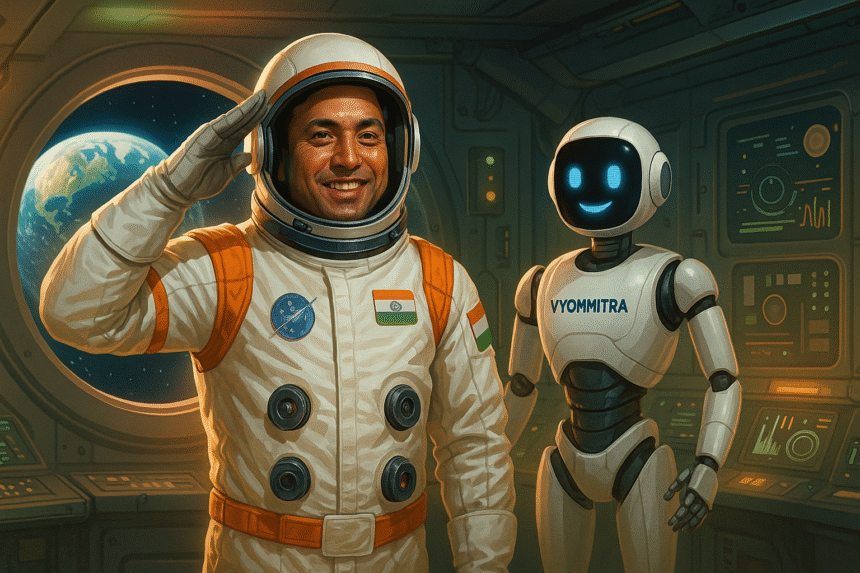Once upon a time, “space” for most Indians meant adjusting three cousins onto one sofa. But not anymore.
- First, What Is Ax-4 and Why Is Everyone Talking About It?
- Gaganyaan: India’s Big Leap into the Cosmos
- Ex-ISRO Chief Gives It the Cosmic Nod
- Why Gaganyaan Matters (Hint: It’s Not Just About Patriotism)
- India’s Astronauts: The Real MVPs
- ISRO’s Progress So Far: More Than Just Rocket Fuel
- International Eyes on India’s Space Story
- Final Thoughts: The Stars Are Aligning
Thanks to a growing cosmic ambition and a pinch of desi jugaad, India is not just reaching for the stars—it’s preparing to send its own people among them. And if the recent Ax-4 mission is anything to go by, ISRO’s upcoming Gaganyaan human spaceflight mission is not just a dream—it’s practically on countdown mode.
But what’s Ax-4 got to do with our homegrown astronauts? Why is the former ISRO chairman beaming with pride? And more importantly, when can we finally say, “Ek Garv Se Kaho: Hamara Astronaut Hai!”?
Let’s break it down like a space science class taught by your favorite Bollywood professor (imagine Boman Irani meets Rocket Boys).
First, What Is Ax-4 and Why Is Everyone Talking About It?
The Axiom Space-4 (Ax-4) mission was launched by SpaceX under a private spaceflight program. But here’s the twist—it had an Indian Air Force pilot, Group Captain Rakesh Sharma– oh wait, that was 1984. Fast forward to 2024–2025, and Wing Commander (Retd.) Rakesh Sharma’s successors are now part of real-time simulation and training protocols modeled on missions like Ax-4.
This mission included a mix of astronauts from different nationalities and backgrounds and focused on scientific research, tech testing, and—most importantly—crew training for future low-Earth orbit operations.
The significance for India? The training modules, mission protocols, and data insights from Ax-4 are being closely studied by Indian space experts and strategists to fine-tune India’s very own Gaganyaan human spaceflight mission.
And that’s where the former ISRO chief steps in with a cosmic thumbs-up.
Gaganyaan: India’s Big Leap into the Cosmos
Let’s not forget, Gaganyaan is not just a mission—it’s an emotion. When Prime Minister Modi first announced it from the Red Fort, it felt like India was finally ready to shift from zero gravity in the astronaut department to actual zero-gravity experience.
Target: Send 2–3 Indian astronauts into space
Altitude: Around 400 km above Earth
Duration: 3 to 7 days
Timeline: 2025 (fingers crossed)
Budget: ₹10,000 crore (that’s a LOT of launch pad laddoos)
The astronauts have been undergoing rigorous training in India and Russia, combining space medicine, survival tactics, flight simulations, and advanced classroom modules (probably tougher than IIT-JEE, just more zero-G).
Ex-ISRO Chief Gives It the Cosmic Nod
Former ISRO Chairman, K Sivan, in a recent interview, said the Ax-4 mission validates India’s astronaut selection and training methods.
Translation: “We’re doing something right, folks!”
According to Sivan, many of the Ax-4 crew protocols matched the exact process Indian astronaut candidates are currently following. From neutral buoyancy lab training (underwater simulations for spacewalks) to re-entry simulations, the blueprint is consistent. Ax-4 just acted like a “proof-of-concept” for India’s human spaceflight vision.
And that’s a huge validation—because space isn’t just about launching rockets anymore; it’s about launching humans safely and bringing them back without turning them into biryani.
Why Gaganyaan Matters (Hint: It’s Not Just About Patriotism)
Sure, it’s emotional to think of someone in a suit floating above Earth with a tricolor patch on their arm. But there are practical and strategic reasons India is investing in human spaceflight:
- National Security: Satellites are vital for defense. Controlling space = controlling data = power.
- Scientific Advancement: Studying microgravity effects helps in medicine, agriculture, and materials science.
- Economic Impact: Space tech drives innovation, job creation, and international collaborations.
- Global Standing: Only a handful of countries have sent humans to space. Joining the elite club is like getting a verified blue tick in the galactic hall of fame.
Plus, let’s not forget the ‘Made in India’ advantage—a successful human space mission could open doors to ISRO offering astronaut training and launch services to smaller spacefaring nations.
India’s Astronauts: The Real MVPs
The current astronaut candidates (names confidential for security reasons) are all IAF test pilots—basically the Avengers of the skies. Handpicked for their nerves of steel and ability to stay calm even if the engine hiccups at Mach 5, these candidates are being trained like elite operatives.
Their schedule includes:
- Aeromedical training
- Survival drills (land, sea, jungle)
- Aircraft handling
- Weightless environment adaptation
- Russian Soyuz capsule simulation
- Cryogenic food taste tests (okay, maybe not the last one)
What makes them cooler? One of them once landed a fighter jet in near-zero visibility. Space is just another sky.
ISRO’s Progress So Far: More Than Just Rocket Fuel
India has already achieved several milestones toward Gaganyaan:
✅ Crew module prototype tested
✅ Escape system (abort system) tested
✅ Mission control center upgraded
✅ Agreements with Russia and France for training and tech support
✅ GSLV Mk-III (launch vehicle) fine-tuned for human spaceflight
The mission is being carefully divided into three parts:
- Unmanned Flight 1 – Tests the capsule systems
- Unmanned Flight 2 – Includes humanoid robot “Vyommitra” (basically our Siri in space suit)
- Manned Flight – The big day!
With lessons from Ax-4, each of these steps now has more accurate simulations, potential failure scenarios, and fallback measures.
International Eyes on India’s Space Story
India’s success with Chandrayaan-3 and the upcoming Aditya-L1 solar mission already earned global admiration. Now with human spaceflight, NASA, ESA, and private players like SpaceX are watching closely.
Why? Because:
- India offers cost-effective solutions
- We’ve proven reliability
- Our software engineers are world-class
- And we’re doing it all at a fraction of the cost
If this continues, Gaganyaan won’t just be a national achievement—it could mark India’s emergence as a global hub for human space missions.
Final Thoughts: The Stars Are Aligning
The Ax-4 mission has, in a way, validated India’s space training standards, given our scientists more confidence, and brought us one step closer to putting India’s name on the interstellar map.
When Gaganyaan lifts off with humans on board, it won’t just be a rocket—it’ll carry the dreams of 1.4 billion people, decades of scientific toil, and the cheeky hope that someday, one of our astronauts will say from orbit:
“Mera Bharat Mahan… aur weightless bhi!”
So keep your eyes on the sky—and your heart in countdown mode. India is gearing up to leave footprints not just on Earth, but soon, in the stars.
Over to you, Vyommitra. 🚀












